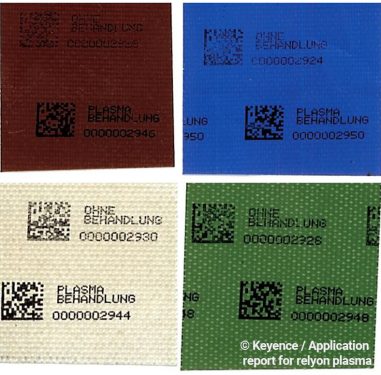
Due to PTFE’s extremely low surface energy, it is difficult for materials to wet, and almost no materials or adhesives readily adhere to it. The commonly known brand name of PTFE-based composition is Teflon – yes, the non-stick stuff. However, plasma can be applied to alter the chemical groups on the surface, increase wettability and creating bonding anchors for the adhesive material.
Recently, a tool solutions company was looking for way to reliably print a Data Matrix Code (DMC) onto PTFE fabric. It turned to the PiezoBrush PZ3-i, in combination with a continuous inkjet printer. The customer tested five different fabrics; once they had been pre-treated with the PZ3-i, the Data Matrix Code was printed in test ink. For all materials tested, the surface energy was less than 30 mN/m without pre-treatment and between 38–42 mN/m after plasma treatment.
Plasma pre-treatment was found to be absolutely essential to reliably mark the fabric, as below a surface energy of 38 mN/m the printed image appeared faded, was not abrasion resistant, and the DMC could not be read. With plasma pre-treatment, the readability of the DMC was good, while resistance to temperature and friction was satisfactory.
This is a great example of where surface pre-treatment enables adhesion where it would otherwise not be possible. The small-scale nature of the PZ3-i meant the customer could achieve a processing performance level that would otherwise only be possible using larger and more expensive equipment, or the use of hazardous chemicals.
The PiezoBrush PZ3-i is designed specifically for integration into fully or partially automated systems, and allows you to combine the effectiveness of plasma surface activation for improved adhesion, wetting, and cleanliness of substrates, with the superior productivity and repeatability of automation. It only requires 24V DC power and dry compressed air, and doesn’t need complex safety enclosures or PPE. The device is intuitive to operate and can be maintained without tools. It is compact, lightweight, modular, safe and efficient, and can be quickly and easily integrated into production lines.
You can read the full case study here: Plasma pre-treatment for PTFE fabric marking
Categories: case study, plasma, surface preparation
